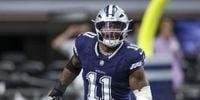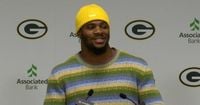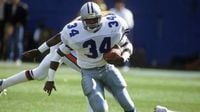The NFL landscape was rocked to its core this week as the Green Bay Packers pulled off a trade that will be talked about for decades. On August 29, 2025, the Packers acquired three-time All-Pro edge rusher Micah Parsons from the Dallas Cowboys in a blockbuster deal that instantly reshapes both franchises. In exchange for Parsons, the Packers sent defensive tackle Kenny Clark—himself a three-time Pro Bowler—and two coveted first-round draft picks (2026 and 2027) to Dallas. The magnitude of this trade has already drawn comparisons to some of the most seismic player moves in NFL history.
Parsons, just 26 years old, arrives in Green Bay with a résumé that is the envy of nearly every defender in the league. Since entering the NFL, he has notched at least 12 sacks in each of his four seasons, including an impressive 12 sacks in just 13 games last year. His ability to generate pressure is simply unmatched: Parsons has racked up 330 quarterback pressures in his first four seasons, outpacing even the likes of Rashan Gary, who managed 280 pressures over six seasons. Notably, since 2021, Parsons has outperformed Myles Garrett (320), Trey Hendrickson (299), and T.J. Watt (232) in this critical defensive metric.
The Packers wasted no time locking up their new star, signing Parsons to a four-year, $188 million contract extension. The deal is historic, making Parsons the highest-paid non-quarterback in NFL history. He will receive $62 million in the first new year of the agreement, with $120 million fully guaranteed and a total of $136 million guaranteed—figures that shatter previous records for defensive players. The Packers’ front office, led by GM Brian Gutekunst, made it clear they were willing to pay a premium for Parsons’ prime years and game-changing ability.
“First of all, I can’t talk about any players on any of the other teams, but I think every opportunity that’s out there that we think could help the Packers, we’re going to take a long look at,” Gutekunst had remarked in the days leading up to the trade. “If that opportunity makes sense to us, then we’ll do it, and if it doesn’t, we won’t.”
For Dallas, the decision to trade Parsons was not taken lightly. The Cowboys receive two first-round picks and a stalwart in Kenny Clark, who has anchored the Packers’ defensive line for years. The move echoes the franchise-altering Herschel Walker trade of 1989, when Dallas shipped their star running back to the Minnesota Vikings in exchange for a haul of draft picks that ultimately fueled their 1990s dynasty. The question now: can the Cowboys repeat history and turn this windfall into another championship run?
Parsons’ departure from Dallas is reminiscent of past NFL megatrades involving generational talents. The trade is already being mentioned in the same breath as the Randy Moss deal to the Patriots, Eric Dickerson’s move to the Colts, Joe Montana’s late-career shift to the Chiefs, and Marshall Faulk’s arrival in St. Louis. Each of those trades dramatically altered the fortunes of both the teams involved and the league as a whole. But few have involved such a young, dominant player at the peak of his powers, or such a massive financial commitment from the acquiring team.
“Every decision affects your football team. Obviously, there are so many different factors in it,” Gutekunst said after the deal was finalized. “Who the player is, medical, cap-wise. But yeah, I think you have to look at everything. Any opportunity to help your football team, you have to look at and discuss as a group. We do that all the time, almost daily.”
Parsons’ impact on the field is undeniable. His rookie campaign saw him line up as an off-ball linebacker, yet he still delivered double-digit sacks—a feat he’s repeated every season since. His versatility is a dream for new defensive coordinator Jeff Hafley, who inherits a defense that now features one of the league’s most feared disruptors. The Packers’ willingness to part with so much draft capital and salary cap space underscores just how much they believe Parsons can elevate their Super Bowl aspirations.
The timing of the trade is also notable, coming just days before the 2025 NFL regular season kicks off on September 4. The move capped a flurry of preseason activity, with teams across the league finalizing their rosters. Yet none of the other recent trades—whether it was the Vikings bringing back Adam Thielen, the Jaguars acquiring Tim Patrick, or the Raiders picking up Kenny Pickett—approached the magnitude of the Parsons deal.
For Dallas, the future now hinges on their ability to capitalize on the assets acquired from Green Bay. The Cowboys have a storied history of leveraging blockbuster trades into long-term success. The parallels to the Herschel Walker trade are impossible to ignore, though Parsons’ age and production arguably make this move even more consequential. Dallas owner Jerry Jones and his front office will be under the microscope as they navigate the next few drafts, hoping to find the next wave of franchise cornerstones.
The Packers, meanwhile, are all-in. By pairing Parsons with a rising young core and an aggressive coaching staff, Green Bay is signaling its intent to chase another Lombardi Trophy. The move also draws comparisons to the team’s signing of Reggie White in free agency over three decades ago—a decision that helped propel the Packers to Super Bowl glory in the 1990s. Fans in Green Bay are already dreaming of similar results with Parsons wreaking havoc off the edge.
As for Parsons, the expectations could not be higher. He joins a franchise with a rich defensive tradition and a fan base hungry for another title. His contract extension ensures he will be the face of the Packers’ defense for years to come. With the regular season about to begin, all eyes will be on Lambeau Field to see how quickly Parsons can make his presence felt in green and gold.
Time will tell whether this trade ultimately delivers a championship to Green Bay or sets Dallas up for another era of dominance. For now, one thing is certain: the Micah Parsons trade has already secured its place among the most monumental deals in NFL history, and its ripple effects will be felt across the league for years to come.


